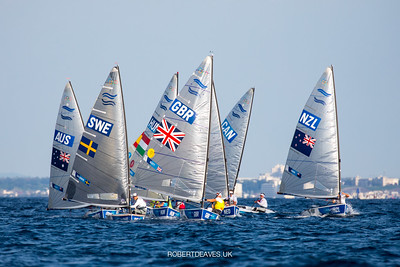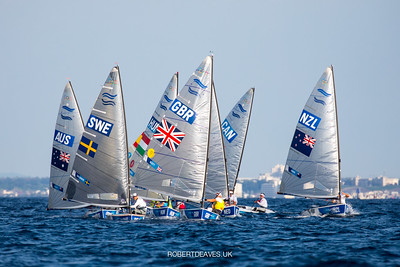Overview
Hobart-based company Tidetech provides detailed and predictive oceanographic data to the commercial shipping industry to save fuel and reduce emissions. It is also used by pro and amateur sailors worldwide to help with navigation and tactics.

While Tidetech’s integrated data platform manages complex and large-scale meteorological and oceanographic datasets, they wanted to improve their coastal modelling capabilities to boost efficiency and improve the accuracy of ocean currents data for their clients.
Challenge
Tidal currents usually dominate the circulation on the continental shelf. But wind-driven currents and their interactions with the tides can also influence conditions of coastal areas. This depends on the size and shape of the shelf and the speed and direction of the winds.
Tidetech wanted to improve its existing modelling capabilities to ensure its clients were receiving the most up to date and accurate ocean current information.
Solution
With the support of the CSIRO Kick-Start program, Tidetech connected with CSIRO Oceans and Atmosphere researcher Dr Clothilde Langlais.
To improve their coastal datasets, Dr Langlais leveraged modelling tools from CSIRO’s Environmental Modelling Suite (EMS), an ocean model developed by CSIRO that analyses the physical, biogeochemical and sediment processes in marine environments. It has been applied at hundreds of locations around the Australian continent, however Tidetech were wanting to test its application along the Japanese coastline. This is the first time the EMS was tested in this part of the world.
So how do ocean models work? Ocean models traditionally mimic the ocean circulation on a finite grid. The grid can have a resolution of 10-100km when you want to simulate the global ocean or a very high resolution of 10-100m when you focus on a small coastal area, with the latter being offered by the EMS.
Incorporating the EMS model into Tidetech’s existing modelling systems helped to simulate tidal currents alongside wind-driven currents resulting in a complex three-dimensional model at a resolution of hundreds of metres, offering a much higher resolution than previously used by the company and more accurate information for their clients.
Results
Tidetech was able to implement EMS ocean model in a coastal region of Japan to develop three-dimensional ocean current forecasts. A daily, seven-day forecast of the ocean conditions was delivered to Olympic sailing teams at the Tokyo games. The forecast included the tidal currents as well as the complex background ocean dynamics of the region, influenced by strong winds and the larger scale Kuroshio Current in east Asia.
As part of a second Kick-Start project, the CSIRO research team has continued to conduct some more intense calibration/validation of the newly developed ocean model to further refine it.
This program is an excellent way for businesses like Tidetech to engage with CSIRO; it is otherwise quite difficult for such relationships to be established. Hopefully the relationship will result in a long-term association beneficial to both businesses.
— Roger Proctor, Science Director, Tidetech
Find out more and apply
- Program Eligibility and Guidelines
- Program Eligibility and Guidelines - text version
- Expressions of Interest form
To find out more about how CSIRO works with small and medium-sized enterprises (SMEs), get in touch with our SME Connect team.
Overview
Hobart-based company Tidetech provides detailed and predictive oceanographic data to the commercial shipping industry to save fuel and reduce emissions. It is also used by pro and amateur sailors worldwide to help with navigation and tactics.

While Tidetech’s integrated data platform manages complex and large-scale meteorological and oceanographic datasets, they wanted to improve their coastal modelling capabilities to boost efficiency and improve the accuracy of ocean currents data for their clients.
Challenge
Tidal currents usually dominate the circulation on the continental shelf. But wind-driven currents and their interactions with the tides can also influence conditions of coastal areas. This depends on the size and shape of the shelf and the speed and direction of the winds.
Tidetech wanted to improve its existing modelling capabilities to ensure its clients were receiving the most up to date and accurate ocean current information.
Solution
With the support of the CSIRO Kick-Start program, Tidetech connected with CSIRO Oceans and Atmosphere researcher Dr Clothilde Langlais.
To improve their coastal datasets, Dr Langlais leveraged modelling tools from CSIRO’s Environmental Modelling Suite (EMS), an ocean model developed by CSIRO that analyses the physical, biogeochemical and sediment processes in marine environments. It has been applied at hundreds of locations around the Australian continent, however Tidetech were wanting to test its application along the Japanese coastline. This is the first time the EMS was tested in this part of the world.
So how do ocean models work? Ocean models traditionally mimic the ocean circulation on a finite grid. The grid can have a resolution of 10-100km when you want to simulate the global ocean or a very high resolution of 10-100m when you focus on a small coastal area, with the latter being offered by the EMS.
Incorporating the EMS model into Tidetech’s existing modelling systems helped to simulate tidal currents alongside wind-driven currents resulting in a complex three-dimensional model at a resolution of hundreds of metres, offering a much higher resolution than previously used by the company and more accurate information for their clients.
Results
Tidetech was able to implement EMS ocean model in a coastal region of Japan to develop three-dimensional ocean current forecasts. A daily, seven-day forecast of the ocean conditions was delivered to Olympic sailing teams at the Tokyo games. The forecast included the tidal currents as well as the complex background ocean dynamics of the region, influenced by strong winds and the larger scale Kuroshio Current in east Asia.
As part of a second Kick-Start project, the CSIRO research team has continued to conduct some more intense calibration/validation of the newly developed ocean model to further refine it.
This program is an excellent way for businesses like Tidetech to engage with CSIRO; it is otherwise quite difficult for such relationships to be established. Hopefully the relationship will result in a long-term association beneficial to both businesses.
— Roger Proctor, Science Director, Tidetech
Find out more and apply
- Program Eligibility and Guidelines PDF (170 KB)
- Program Eligibility and Guidelines - text version TXT (11 KB)
- Expressions of Interest form
To find out more about how CSIRO works with small and medium-sized enterprises (SMEs), get in touch with our SME Connect team.
